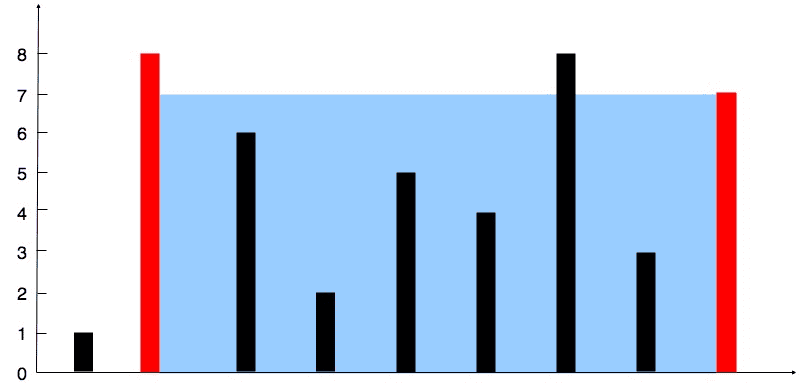Problem
Write a function:
function maxArea(height);that, given n positive integers a1, a2, ..., an , where each represents a point at coordinate (i, ai). n vertical lines are drawn such that the two endpoints of the line i is at (i, ai) and (i, 0). Find two lines, which, together with the x-axis forms a container, such that the container contains the most water.
Note: You may not slant the container.
Examples
- Given
height = [1,8,6,2,5,4,8,3,7], the function should return49.
Explanation: The above vertical lines are represented by array [1,8,6,2,5,4,8,3,7]. In this case, the max area of water (blue section) the container can contain is 49.
- Given
height = [1,1], the function should return1. - Given
height = [4,3,2,1,4], the function should return16. - Given
height = [1,2,1], the function should return2.
Write an efficient algorithm for the following assumptions
n == height.length2 <= n <= 1050 <= height[i] <= 104
You can find the link of the question here.
Solutions
Brute force solution
/**
* @param {number[]} height
* @return {number}
*/
function maxArea(height) {
let maxArea = 0;
for (let i = 0; i < height.length; i++) {
for (let j = i + 1; j < height.length; j++) {
const currArea = Math.min(height[i], height[j]) * (j - i);
maxArea = Math.max(maxArea, currArea);
}
}
return maxArea;
}BigO Notation
| Time | Space |
|---|---|
| O(N^2) | O(1) |
Optimal Solution
/**
* @param {number[]} height
* @return {number}
*/
function maxArea(height) {
let maxArea = 0;
let leftPointer = 0;
let rightPointer = height.length - 1;
while (leftPointer < rightPointer) {
const currArea =
Math.min(height[leftPointer], height[rightPointer]) *
(rightPointer - leftPointer);
if (height[leftPointer] < height[rightPointer]) {
leftPointer++;
} else {
rightPointer--;
}
maxArea = Math.max(maxArea, currArea);
}
return maxArea;
}BigO Notation
| Time | Space |
|---|---|
| O(N) | O(N) |
Solution in Python
class Solution:
def maxArea(self, height: List[int]) -> int:
max_area = 0
left_pointer = 0;
right_pointer = len(height) - 1
while left_pointer < right_pointer:
curr_area = min(height[left_pointer], height[right_pointer]) * (right_pointer - left_pointer)
max_area = max(curr_area, max_area)
if height[left_pointer] < height[right_pointer]:
left_pointer += 1
else:
right_pointer -= 1
return max_area
The solutions above are pretty self-explanatory.
💌 If you’d like to receive more coding solutions in your inbox, you can sign up for the newsletter here.


Discussions